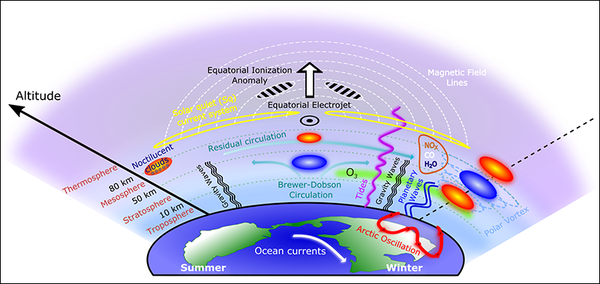- Forschungsthemen
- Abteilung Optische Sondierungen und Höhenforschungsraketen
- Abteilung Radarsondierungen
- Abteilung Modellierung atmosphärischer Prozesse
- Arbeitsgruppe Satellitendatenanalyse
- Abteilungsübergreifende Zusammenarbeit
- Projekte
- Veröffentlichungen
Understanding the role of ozone in atmosphere-ionosphere coupling during sudden stratospheric warmings
The Earth’s ionosphere displays significant day-to-day variability. Knowledge about the processes that drive these variability is important nowadays as much of our communication and navigation
capabilities rely on satellite signals that pass through the ionosphere. These processes arise from either solar and magnetospheric origin (usually referred to as “forcing from above”) or meteorological origin
(referred to as “forcing from below”). The ionospheric variability due to lower atmospheric forcing form below becomes particularly apparent during extreme meteorological events known as sudden
stratospheric warmings (SSWs).

respectively.
SSWs are characterized by a sudden increase in the polar stratospheric temperature and in extreme cases can result in the reversal of the climatological westerly zonal-mean zonal winds associated with the stratospheric polar night jet. The SSW related effects are not only limited to the stratospheric altitudes, but rather extensive changes are observed throughout the Earth’s atmosphere (see Figure 1). Observational and numerical studies have suggested changes in the solar and lunar tides at mesosphere-lower thermosphere (MLT) altitudes and above as one of the primary mechanisms to explain the changes in the ionosphere during SSWs. These tidal changes are considered to be driven by changes in the ozone forcing of the migrating semidiurnal solar (SW2) tide, changes in the tidal propagation conditions, and nonlinear planetary wave-tide interactions. The changes in the stratospheric circulation during SSWs can lead to profound effects on the distribution of stratospheric ozone. Due to the change in the ozone concentration, the generation of SW2 is likely to be affected. As the SW2 tidal variability during SSWs, lead to major changes in the MLT region, it is important to investigate the potential role of stratospheric ozone for a better understanding of the coupling mechanisms. Through the awarded Humboldt Fellowship, I seek to address the following research questions (RQs) and understand the impact of ozone on the ionospheric variability during SSWs.
- RQ1: Does the change in the stratospheric ozone distribution during SSWs cause major SW2 tidal variability in the MLT region?
- RQ2: Do the SW2 variability due to ozone distribution during SSWs lead to major changes in the equatorial E×B drifts?
- RQ3: What are the effects associated with the ozone variability during SSWs on the non-migrating solar tides in the MLT region and the ionosphere?
For this purpose, numerical simulations using the Whole Atmosphere Community Climate Model (WACCM) and Thermosphere-Ionosphere Electrodynamics General Circulation Model (TIE-GCM) are being employed. As a first step, the widely studied 2009 SSW event has been simulated using two WACCM setups that allows the separation of ozone forcing by incorporating dynamical and specified chemistry modules in WACCM and the effects at MLT altitudes have been studied. The next step, currently underway, involves running the TIE-GCM with WACCM meteorological fields at its lower boundary to study the impact of stratospheric ozone variability on the ionosphere during SSWs.
Contact
Es wurden keine Mitarbeiter ausgewählt.












